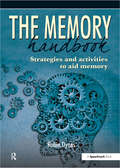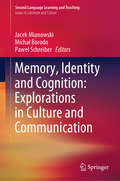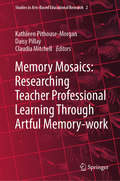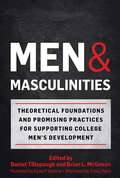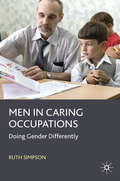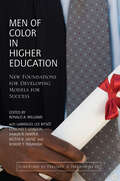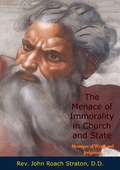- Table View
- List View
Memory Games for Groups
by Robin DynesThis wonderfully practical handbook features 80 adaptable and photocopiable games for uses with older people, as well as individuals or groups of all ages. The games can be used as part of a social activities programme, specifically for reminiscence purposes, to help keep people orientated to the world around them, to exercise memory skills or as the prelude to discussion, so that individuals can share difficulties and explore methods of aiding memory.
Memory Games for Groups
by Robin DynesThis wonderfully practical handbook features 80 adaptable and photocopiable games for uses with older people, as well as individuals or groups of all ages. The games can be used as part of a social activities programme, specifically for reminiscence purposes, to help keep people orientated to the world around them, to exercise memory skills or as the prelude to discussion, so that individuals can share difficulties and explore methods of aiding memory.
The Memory Handbook: Strategies and Activities to Aid Memory
by Robin DynesThis is a handbook full of practical ideas to use with anyone who is experiencing mild to severe memory difficulties. The suggestions and activities can be used when working with individuals or groups. The strategies can, in fact, be used by anyone young or old, who has become worried about loss of memory. The handbook provides: information about how memory works and different types of memory; an outline of what can affect memory; strategies to aid memory; activities to practice using the strategies; and activities to keep the brain active and maintain memory. The resource is aimed at staff in care environments such as residential homes, day centres, social clubs, support groups, carers or anyone who might be concerned about loss of memory. It promotes understanding about memory difficulties and provides a wide range of strategies and activities to aid response to individual need. Approximately 200pp; A4 wire-o-bound.
The Memory Handbook: Strategies and Activities to Aid Memory
by Robin DynesThis is a handbook full of practical ideas to use with anyone who is experiencing mild to severe memory difficulties. The suggestions and activities can be used when working with individuals or groups. The strategies can, in fact, be used by anyone young or old, who has become worried about loss of memory. The handbook provides: information about how memory works and different types of memory; an outline of what can affect memory; strategies to aid memory; activities to practice using the strategies; and activities to keep the brain active and maintain memory. The resource is aimed at staff in care environments such as residential homes, day centres, social clubs, support groups, carers or anyone who might be concerned about loss of memory. It promotes understanding about memory difficulties and provides a wide range of strategies and activities to aid response to individual need. Approximately 200pp; A4 wire-o-bound.
Memory, Identity and Cognition: Explorations in Culture and Communication (Second Language Learning and Teaching)
by Michał Borodo Jacek Mianowski Paweł SchreiberThe book analyses a variety of topics and current issues in linguistics and literary studies, focusing especially on such aspects as memory, identity and cognition. Firstly, it discusses the notion of memory and the idea of reimagining, as well as coming to terms with the past. Secondly, it studies the relationship between perception, cognition and language use. It then investigates a variety of practices of language users, language learners and translators, such as the use of borrowings from hip-hop and slang. The book is intended for researchers in the fields of linguistics and literary studies, lecturers teaching undergraduate and master’s students on courses in language and literature.
Memory in Education (Ed Psych Insights)
by Robert Z. Zheng Michael K. GardnerAs our understanding of the human memory system broadens and develops, new opportunities arise for improving students’ long-term knowledge retention in the classroom. Written by two experts on the subject, this book explores how scientific models of memory and cognition can inform instructional practices. Six chapters guide readers through the information processing model of memory, working and long-term memory, and Cognitive Load Theory (CLT) before addressing instructional strategies. This accessible, up-to-date volume is designed for any educational psychology or general education course that includes memory in the curriculum and will be indispensable for student researchers and both pre- and in-service teachers alike.
Memory in Education (Ed Psych Insights)
by Robert Z. Zheng Michael K. GardnerAs our understanding of the human memory system broadens and develops, new opportunities arise for improving students’ long-term knowledge retention in the classroom. Written by two experts on the subject, this book explores how scientific models of memory and cognition can inform instructional practices. Six chapters guide readers through the information processing model of memory, working and long-term memory, and Cognitive Load Theory (CLT) before addressing instructional strategies. This accessible, up-to-date volume is designed for any educational psychology or general education course that includes memory in the curriculum and will be indispensable for student researchers and both pre- and in-service teachers alike.
Memory Mosaics: Researching Teacher Professional Learning Through Artful Memory-work (Studies In Arts-based Educational Research Ser. #2)
by Kathleen Pithouse-Morgan Daisy Pillay Claudia MitchellThis book communicates new voices, insights, and possibilities for working with the arts and memory in researching teacher professional learning. The book reveals how, through the arts, teacher-researchers can reimagine and reinvigorate moments of the past as embodied and empowering scholarly experiences. The peer-reviewed chapters were composed from juxtaposing unique “mosaic” pieces written by 21 new and emerging scholars in South Africa and Canada. Their research explores diverse arts-based practices and resources including collage, film, drawing, narrative, poetry, photography, storytelling and television alongside related ethical issues. Critically, Memory Mosaics also demonstrates how artful memory-work can engender agency in professional learning with teacher-researchers taking up pressing issues of social justice such as inclusion and decolonisation. Overall, the book offers a multidimensional, polyvocal exploration of how artful memory-work can bring about future-oriented professional learning enacted as pedagogies of reinvention and productive remembering.Memory Mosaics: Researching Teacher Professional Learning Through Artful Memory-Work, by Kathleen Pithouse-Morgan, Daisy Pillay, and Claudia Mitchell, along with teacher-researchers on two continents, is a ground-breaking book. It models a collaborative approach to arts-based research that melds memory-work, visual and poetic arts, and reflective practice to promote professional learning, personal transformation, decolonisation, and a more just future. Like colourful pebbles and bits of glass, the authors place teachers’ self-stories in relation to one another in an artful design, creating thematic coherence that evokes a deep sense of knowing. Judith C. Lapadat, Professor Emeritus, Faculty of Education, University of Lethbridge, CanadaMemory Mosaics: Researching Teacher Professional Learning Through Artful Memory-Workassembles exemplars of professional learning in an intriguing mosaic format. A topic is introduced, followed by memory-pieces; then: discussion and/or creative response. This lively juxtaposition generates momentum for highly productive forms of remembering around social justice issues, even as the reader is invited into an intimate circle of shared concern: for these issues, with these (and other) teacher-researchers. It is a beautiful, original, and practical book. Teresa Strong-Wilson, Associate Professor, Faculty of Education, McGill University, Canada
The Memory of Clothes
by Robyn GibsonOnce hanging static in a wardrobe or folded away in a trunk, in recent times clothes have found themselves thrown into the spotlight. The crowds that are drawn to large scale fashion exhibitions staged with increasing frequency in galleries and museums around the world offer glimpses into the meaning that we attach to these items of clothing. Apart from their aesthetic value, clothes have the ability to evoke issues of identity, of the relation of self to body and self to the world. We are able to find ourselves through the experiences of delving into our wardrobes and remembering. Clothes are thus layered with meaning since they have the power to act as memory prompts. Woven into their fabric are traces of past experiences; stitched into their seams are links to people we have loved and lost. Viewed as visual objects, clothing is not frivolous, flippant or foolish. In telling and talking about clothes, we reveal much about ourselves, our lives and the experiences that we drape around our bodies. Whether bought or handmade, passed down or reconstructed, clothes help us to construct meaning as we remember those things in our lives that matter.
Men and Masculinities: Theoretical Foundations and Promising Practices for Supporting College Men's Development
by Daniel Tillapaugh, Brian L. McGowan, Ryan P. Barone, Tracy DavisThere continues to be much concern about the retention and persistent of men in college, particularly Black, Latinx, and Native American men. In addition, queer and trans* men also have found institutions to be problematic spaces. For those who do persist, we know that men are overrepresented in student conduct cases and engage in risky behaviors around alcohol, drug use, and sexual relationships. Additionally, we know that college men have historically avoided engaging in help-seeking behaviors for their academic and personal success. This book addresses the ways that theory can be put into practice for powerful, transformative learning to support college men and their development.This book synthesizes the research of the past three decades on college men to inform college student educators on the developmental needs of college men and illuminates how young men are socialized prior to their arrival to campus, but perhaps more importantly, how the collegiate environment becomes a training ground for the socialization of masculinities by students, their peers, and their environments.Beyond that, it sets out how practitioners can help young men understand why and how they have been socialized around their gender identity, but also what their gender identity and sense of masculinity means for their future selves. The book highlights programs and services designed to have college men engage with and dialogue around issues of hegemonic, toxic, or unhealthy aspects of masculinity. These promising practices can offer college men opportunities to understand their power, privilege, and identity in ways that can be affirming and healthier, leading to more life-giving chances. This is all the more important in the context of an ever-evolving society where traditionally held norms and expectations around gender--particularly masculinities--are shifting. This book equips student affairs staff, faculty, and administrators to better support college men’s development. It offers readers insights, ideas, and models for adapting and developing programs, services, and initiatives that may meaningfully meet the needs of specific student populations, while recognizing that there is no “one-size-fits-all” approach to this work.
Men and Masculinities: Theoretical Foundations and Promising Practices for Supporting College Men's Development
There continues to be much concern about the retention and persistent of men in college, particularly Black, Latinx, and Native American men. In addition, queer and trans* men also have found institutions to be problematic spaces. For those who do persist, we know that men are overrepresented in student conduct cases and engage in risky behaviors around alcohol, drug use, and sexual relationships. Additionally, we know that college men have historically avoided engaging in help-seeking behaviors for their academic and personal success. This book addresses the ways that theory can be put into practice for powerful, transformative learning to support college men and their development.This book synthesizes the research of the past three decades on college men to inform college student educators on the developmental needs of college men and illuminates how young men are socialized prior to their arrival to campus, but perhaps more importantly, how the collegiate environment becomes a training ground for the socialization of masculinities by students, their peers, and their environments.Beyond that, it sets out how practitioners can help young men understand why and how they have been socialized around their gender identity, but also what their gender identity and sense of masculinity means for their future selves. The book highlights programs and services designed to have college men engage with and dialogue around issues of hegemonic, toxic, or unhealthy aspects of masculinity. These promising practices can offer college men opportunities to understand their power, privilege, and identity in ways that can be affirming and healthier, leading to more life-giving chances. This is all the more important in the context of an ever-evolving society where traditionally held norms and expectations around gender--particularly masculinities--are shifting. This book equips student affairs staff, faculty, and administrators to better support college men’s development. It offers readers insights, ideas, and models for adapting and developing programs, services, and initiatives that may meaningfully meet the needs of specific student populations, while recognizing that there is no “one-size-fits-all” approach to this work.
Men and Masculinities in Global English Language Teaching
by R. ApplebyThis book draws on a range of sources, including tales of castaways, fictional narratives, and interviews with teachers in conversation schools and universities in Japan, to explore many current concerns around teacher identity, gender, and intercultural sexuality in global English language teaching.
Men in Caring Occupations: Doing Gender Differently
by R. SimpsonExploring how men in service and caring occupations (cabin crew, primary school teachers, nurses and librarians) both 'do' and 'undo' gender as they manage the potential mismatch between gender and occupational identity, this book engages with the key theoretical concepts of identity, visibility and emotions to examine men's experiences.
Men in Early Childhood Education and Care: Gender Balance and Flexibility (Palgrave Studies in Gender and Education)
by Jo WarinThis book examines the current interest in recruiting and supporting more men in the early childhood education workforce. Drawing on extensive empirical data from case studies of an unusual English preschool setting and interviews with Swedish male preschool staff, the author explores the potential benefits to society linked to the increased presence of men in early childhood education, and how this might be achieved. Throughout the book, the author maintains that the potential of including more men in early childhood education can only be achieved by gender-sensitive practitioners, both women and men, who are willing to create a gender-flexible pedagogy. This volume will be of interest and value to students, academics and practitioners interested in gender diversity and equity within early childhood education and care.
Men in Early Childhood Education and Care: Gender Balance and Flexibility (Palgrave Studies in Gender and Education)
by Jo WarinThis book examines the current interest in recruiting and supporting more men in the early childhood education workforce. Drawing on extensive empirical data from case studies of an unusual English preschool setting and interviews with Swedish male preschool staff, the author explores the potential benefits to society linked to the increased presence of men in early childhood education, and how this might be achieved. Throughout the book, the author maintains that the potential of including more men in early childhood education can only be achieved by gender-sensitive practitioners, both women and men, who are willing to create a gender-flexible pedagogy. This volume will be of interest and value to students, academics and practitioners interested in gender diversity and equity within early childhood education and care.
Men in Early Years Settings: Building a Mixed Gender Workforce
by David Wright Simon BrownhillThis book explores the role of male professionals in early years settings and provides guidance for early years practitioners, managers and policy makers on building a more mixed-gender workforce by successfully attracting, recruiting, retaining and developing men in their teams.Men make up less than 2% of the early years workforce in England. This book considers the reasons for the current situation, asks whether there is a case for change and suggests ways of achieving a more mixed-gender early years workforce. The voices of male and female practitioners, providers and parents help to illustrate the barriers to men entering and successfully working in the sector, whilst also suggesting ways these barriers can be broken down.
Men in Early Years Settings: Building a Mixed Gender Workforce
by David Wright Simon BrownhillThis book explores the role of male professionals in early years settings and provides guidance for early years practitioners, managers and policy makers on building a more mixed-gender workforce by successfully attracting, recruiting, retaining and developing men in their teams.Men make up less than 2% of the early years workforce in England. This book considers the reasons for the current situation, asks whether there is a case for change and suggests ways of achieving a more mixed-gender early years workforce. The voices of male and female practitioners, providers and parents help to illustrate the barriers to men entering and successfully working in the sector, whilst also suggesting ways these barriers can be broken down.
Men in the Nursery: Gender and Caring Work (PDF)
by Dr Charlie Owen Peter Moss Professor Claire CameronHighly Commended (Third prize) in the Standing Conference on Studies in Education book prize for books published in 1999. `It was a breath of fresh air to see 'contentious' issues dealt with in an enlightened and informative way. We are certain it will move the debate on years!' - Chrissie Meleady, Sheffield Childrens' Centre `Looks most interesting and will certainly be very useful' - Bronwen Cohen, Director, Children in Scotland `It's a challenging and exciting book and I hope it is widely used' - Margy Whalley, Director, Pen Green Research, Development and Training Base, Pen Green Centre for Under 5's and Their Families `An extremely interesting account. This book highlights some very important tensions and contradictions about the role of men in childcare work. The differing perceptions of women and men concerning men's involvement in childcare are particularly thoughtfully documented' - Peter Aggleton, Director, Thomas Coram Research Unit, University of London `An essential book for the debate on gender and childcare... the more academic childcare students will cope with it, will be good for Second year BTEC students, `A' Level students' - Robin Wright, Lecturer, Bournemouth and Poole College of Higher Education `Having been a lone male worker, this book has stimulate discussion on gender and how we need to wrestle and value difference. For that reason alone its worth buying' - Practical Parenting
Men, Masculinities and Teaching in Early Childhood Education: International perspectives on gender and care
by Simon Brownhill Jo Warin Inga WernerssonThis stimulating book sets out to critically explore the notion of men, masculinities and teaching in early childhood education. It addresses the global pattern of gender, teaching and care where men are in the minority, and explores the notion that the greater involvement of men within teaching and associated professions has the potential to transform gender relations for future generations. International contributors raise critical questions about the construction of masculinities, the continuing reluctance of men to engage in this type of work, and the influence of political and public debates on the issue. Through this engaging discussion readers are asked to question whether this is something that we should care about, with key topics including: The roles of men in education and care Teachers’ beliefs, norms and values of gender equality The construction of male identities Gendered ideals, and children’s interpretations of gender. Men, Masculinities and Teaching in Early Childhood Education brings together a refreshing and critical set of perspectives linked to an increasingly important educational debate and will be a valuable text for practitioners, professionals, policy makers and parents/carers.
Men, Masculinities and Teaching in Early Childhood Education: International perspectives on gender and care
by Simon Brownhill Jo Warin Inga WernerssonThis stimulating book sets out to critically explore the notion of men, masculinities and teaching in early childhood education. It addresses the global pattern of gender, teaching and care where men are in the minority, and explores the notion that the greater involvement of men within teaching and associated professions has the potential to transform gender relations for future generations. International contributors raise critical questions about the construction of masculinities, the continuing reluctance of men to engage in this type of work, and the influence of political and public debates on the issue. Through this engaging discussion readers are asked to question whether this is something that we should care about, with key topics including: The roles of men in education and care Teachers’ beliefs, norms and values of gender equality The construction of male identities Gendered ideals, and children’s interpretations of gender. Men, Masculinities and Teaching in Early Childhood Education brings together a refreshing and critical set of perspectives linked to an increasingly important educational debate and will be a valuable text for practitioners, professionals, policy makers and parents/carers.
Men of Color in Higher Education: New Foundations for Developing Models for Success
by Freeman A. Hrabowski III Ronald A. Williams LeManuel Lee Bitsóí Edmund T. Gordon Shaun R. Harper Victor B. Sáenz Robert T. TeranishiGiven the continued plight of men of color in college after a decade of ineffective interventions focused more on “fixing the student” than on addressing the social, structural and institutional forces that undermine his academic achievement, this book is intended as a catalyst to change the direction of the dialogue, by providing a new theoretical framework and strength-based models for developing strategies for success.This book brings together five of today’s leading scholars concerned with the condition of males of color in higher education – LeManuel Bitsóí, Edmund T. Gordon, Shaun Harper, Victor Sáenz and Robert Teranishi, who collaborated closely through of a series of conversations convened by the College Board to diagnose the common factors impeding the success of under-represented males and to identify the particular barriers and cultural issues pertaining to the racial and ethnic groups they examine.This cohesive volume starts with the recognition that understanding males' disengagement from the classroom requires determining what it means to be a male in a non-dominant group in today’s society. The authors use the methods of feminist theory to uncover the impact of dominant paradigms of White, middle-class, heteronormative masculinity on men of color in general, to define what comprises masculinity for various groups, subgroups and individuals, and to lay bare the social and institutional forces that perpetuate constructions of masculinity that negatively impact men of color. They demonstrate that researchers and practitioners alike must pay more careful attention to within-group diversity as they study college men of color and create initiatives that respond to their varied needs. They establish the need for men of color campus initiatives to be mindful of the masculinities with which students enter college, as well as how they develop, negotiate and perform their gender identities on campus; the vital importance, in developing programs and interventions, of addressing the sociological undercurrents of men’s bad behaviors and poor help-seeking tendencies; and for providing opportunities for men to engage in critical individual and collective reflection on how they have been socialized to think of themselves as men.This book advances the critical priorities of increasing enrollments and completion rates among college men of color, and of graduating well-developed men with strong, conflict-free gender identities. For practitioners who work with these populations, it offers insights and signposts to create successful programs; for researchers it offers a set of new directions for analysis; and for policymakers, new ways of thinking about how policy and funding mechanisms ought to be reconsidered to be more effective in responding this issue.
Men of Color in Higher Education: New Foundations for Developing Models for Success
Given the continued plight of men of color in college after a decade of ineffective interventions focused more on “fixing the student” than on addressing the social, structural and institutional forces that undermine his academic achievement, this book is intended as a catalyst to change the direction of the dialogue, by providing a new theoretical framework and strength-based models for developing strategies for success.This book brings together five of today’s leading scholars concerned with the condition of males of color in higher education – LeManuel Bitsóí, Edmund T. Gordon, Shaun Harper, Victor Sáenz and Robert Teranishi, who collaborated closely through of a series of conversations convened by the College Board to diagnose the common factors impeding the success of under-represented males and to identify the particular barriers and cultural issues pertaining to the racial and ethnic groups they examine.This cohesive volume starts with the recognition that understanding males' disengagement from the classroom requires determining what it means to be a male in a non-dominant group in today’s society. The authors use the methods of feminist theory to uncover the impact of dominant paradigms of White, middle-class, heteronormative masculinity on men of color in general, to define what comprises masculinity for various groups, subgroups and individuals, and to lay bare the social and institutional forces that perpetuate constructions of masculinity that negatively impact men of color. They demonstrate that researchers and practitioners alike must pay more careful attention to within-group diversity as they study college men of color and create initiatives that respond to their varied needs. They establish the need for men of color campus initiatives to be mindful of the masculinities with which students enter college, as well as how they develop, negotiate and perform their gender identities on campus; the vital importance, in developing programs and interventions, of addressing the sociological undercurrents of men’s bad behaviors and poor help-seeking tendencies; and for providing opportunities for men to engage in critical individual and collective reflection on how they have been socialized to think of themselves as men.This book advances the critical priorities of increasing enrollments and completion rates among college men of color, and of graduating well-developed men with strong, conflict-free gender identities. For practitioners who work with these populations, it offers insights and signposts to create successful programs; for researchers it offers a set of new directions for analysis; and for policymakers, new ways of thinking about how policy and funding mechanisms ought to be reconsidered to be more effective in responding this issue.
Men Teaching Children 3-11: Dismantling Gender Barriers
by Elizabeth Burn Simon Pratt-AdamsMen Teaching Children 3-11 provides a comprehensive exploration of work experiences of men who teach young children. The authors draw on their own research as well as international studies to provide realistic strategies to help to remove barriers in order to develop a more gender-balanced teacher workforce. Burn and Pratt-Adams, former primary school teachers who have both experienced these unfair gender practices, also trace the historical roots of the gender barriers that have now become embedded within the occupational culture.Throughout Men Teaching Children 3-11, the authors argue that primary school teachers should be judged by their teaching talents, rather than by the application of biased gender stereotypes; and that male and female teachers need to work together to remove these stereotypes from the occupation.
Men Teaching Children 3-11: Dismantling Gender Barriers
by Elizabeth Burn Simon Pratt-AdamsMen Teaching Children 3-11 provides a comprehensive exploration of work experiences of men who teach young children. The authors draw on their own research as well as international studies to provide realistic strategies to help to remove barriers in order to develop a more gender-balanced teacher workforce. Burn and Pratt-Adams, former primary school teachers who have both experienced these unfair gender practices, also trace the historical roots of the gender barriers that have now become embedded within the occupational culture.Throughout Men Teaching Children 3-11, the authors argue that primary school teachers should be judged by their teaching talents, rather than by the application of biased gender stereotypes; and that male and female teachers need to work together to remove these stereotypes from the occupation.
The Menace of Immorality in Church and State: Messages of Wrath and Judgment
by John D.“THE following messages are printed in response to many requests for their publication. I have allowed the local coloring to remain in the discourses, because I felt that these elements might add to the vitality of the messages, and make them more concrete and real.“I have not softened the messages, either, by ‘retouching’ them. These messages were stenographically reported, and they are given here just as God gave them to the messenger,—hot from the heart.“Happily, however, we are getting away from that false modesty which is not willing to talk about these evils, in order that they may be exposed and corrected, but is willing to tolerate them in guilty and shameful silence. We need to substitute the challenging tones of truth for this cowardly and prudish reserve. We need to speak out. We need knowledge of these secret enemies of our homes. These evils feed on silence and grow by stealth, and we ought today to tell the whole truth and not compromise with evil. ‘Ye shall know the truth and the truth shall make you free.’ As in Hosea’s day, thousands and tens of thousands are being ‘destroyed for lack of knowledge.’ Men and women, boys and girls,—our children, our brothers and our sisters,—are going down. Surely it is our duty to unmask the sources of their destruction, and to seek by all honest and legitimate means to defend ourselves against these secret assailants of the sanctity of the church, the purity of the home, the good order of the state, and the very life of the nation itself.After every war, there is a wave of immorality. We have just passed through the greatest war of all time, and we are now witnessing the widest wave of immorality in the history of the human race. Like a consuming fire, it is sweeping over the world. Only a spurious and silly optimism can deny this fact. All who really know conditions, both in Europe and America, confirm the fact.”—Rev. John Roach Straton

